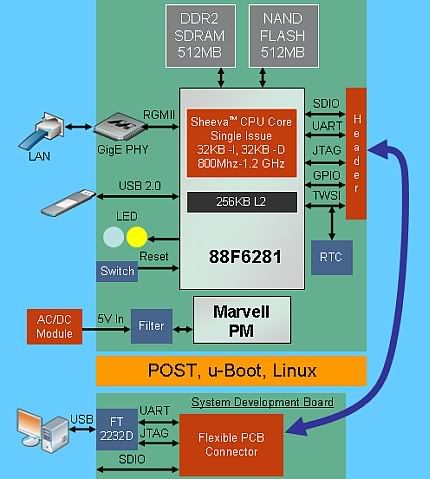BITS BLOG. |
| Plugging In $40 Computers By Saul Hansell. May 21, 2009, 7:45 am |
|
|
What would you do with a $40 Linux computer the size of a three-prong plug adapter? |
|
It has created a "plug computer." It's a tiny plastic box that you plug into an electric outlet. There's no display. But there is an Ethernet jack to connect to a home network and a USB socket for attaching a hard drive, camera or other device. Inside is a 1.2 gigahertz Marvell chip, called an application processor, running a version of the Linux operating system. All this can be yours for $99 today and probably for under $40 in two years. |
|
|
| "There's not much in there," said Sehat Sutardja, Marvell's chief executive and co-founder, just a few chips and the sort of power supply used to charge a cellphone battery. Because this computer uses chips designed for cellphones, it uses far less power than chips designed for regular computers. In its 13 years of existence, Marvell Technology Group has become a major player in semiconductors, with annual sales of more than $2 billion a year. It makes more than half of the microprocessors that control hard disk drives and is also a supplier of chips that go into cellphones. Mr. Sutardja envisions an explosion of innovation about to hit home users because of the combination of open-source software and very powerful chips that are becoming available at very low costs. The first plausible use for the plub computer is to attach one of these gizmos to a USB hard drive. Voila, you've got a network server. CloudEngines, a startup, has in fact built a $99 plug computer called Pogoplug, that will let you share the files on your hard drive, not only in your home but also anywhere on the Internet. "This creates a smart data center for the home," Mr. Sutardja said. Another application might be to connect a security camera to the Internet, adding enough intelligence to help analyze images to distinguish between a stray dog and a cat burglar. |
|
|
| Scientific American asked some "alpha geeks" at the Massachusetts Institute of Technology's Computer Science and Artificial Intelligence Laboratory what they might do with a plug computer. One researcher imagined a system to automatically turn on and off appliances as people moved around the house. Another described a "life filter" that might weed out boring e-mails before sending them on to his computer. Ultimately, these computers may well be used in more mainstream devices, especially for home entertainment. "We wanted to seed the thinking of people in the market place with what you can do with our processors," Mr. Sutardja said. "Eventually you won't see the plug. We want this device to be in your TV, your stereo system, your DVD player." The Marvell chips are based on designs by ARM Holdings, which have emerged as the leading rival to Intel's x86 chip architecture. ARM dominates the cellphone market because of its chips' low power usage. ARM licenses its designs to Marvell and many other chipmakers. A year ago, Warren East, the chief executive of ARM, predicted what would happen when the price of ARM's processors fell from the $10 range to 50 cents. At that level, every light switch may well be an Internet connected computer, he said. The plug computer idea is clearly a step in that direction. And it is part of an even broader array of chips designed initially for phones that will add features to many other devices. Mr. Sutardja talked about the sort of digital photo frame you can now buy for about $50. Add $2 in chips, and it can display high definition movies, he said. Another $2 adds a camera. And less than a dollar adds several microphones. "You now have the sort of video conferencing that corporations buy for much more money," he said. Not surprisingly, in Mr. Sutardja's view, it is the sort of brain that Marvell makes that will be in the center of all this. "The uses of an application processor are endless," he said. "It is up to smart people to imagine what it can do." |
jueves, mayo 21, 2009
Enchufes/Computadoras a $99 dólares.
Suscribirse a:
Comentarios de la entrada (Atom)



No hay comentarios.:
Publicar un comentario